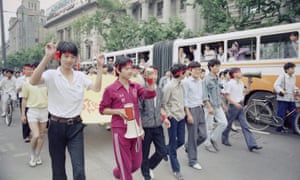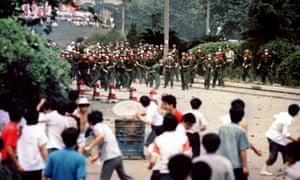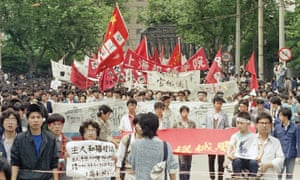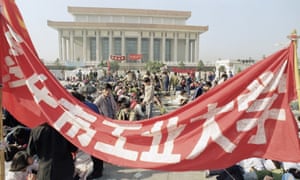Luke Skywalker
Super Moderator

Observer special report
China’s other Tiananmens: 30 years on
Students march in Shanghai on 10 June 1989, after authorities warned that illegal gatherings would be punished. Photograph: Mitsuhiko Sato/AP
Hundreds of other Chinese cities were also suppressed and are now forgotten after a media clampdown
by Lily Kuo
Main image: Students march in Shanghai on 10 June 1989, after authorities warned that illegal gatherings would be punished. Photograph: Mitsuhiko Sato/AP
Sun 2 Jun 2019 09.00 BST
In the spring of 1989, Zhou Guocong had just finished school and taken a job at a pipe factory to help his family – farmers living on the outskirts of Chengdu. At the age of 17 and the youngest of four, he was still a child in many ways. He played with his nieces and nephews and enjoyed cartoons. He was known for being introverted, but loving.
On 6 June, Zhou went out, telling his mother he was heading “to play”, and never came home. For the past three decades, Zhou’s mother, Tang Deying, 83, has been seeking redress for the death of her son, one of dozens believed killed in Chengdu as police moved to put down student protests, after Chinese troops did the same a thousand miles away in the capital.
Between April and early June 1989, the south-western Chinese city had been overtaken by students protesting in solidarity with their peers in Tiananmen Square in Beijing. In the early hours of 4 June, those students were shot or crushed by tanks as the military cleared the square. In Chengdu, enraged students and citizens poured on to the streets, demanding “blood for blood”. Following Beijing’s lead, the city’s security forces were deployed.
Tiananmen Square 30 years on: ‘At 3am, I feared I might be killed’
Read more
Amid the chaos, Tang went looking for her son, talking to his former classmates and their relatives. After a few days, the family learned he had been detained by police. After two months, they received confirmation he had died. Zhou’s sister, Guoyun, who was 20 at the time, remembers her parents sobbing in the next room. “It was a sleepless night,” she told the Observer. As she recalls it, her father’s hair turned white overnight.
The police never explained how Zhou died in their custody. After 11 years of constant trips to the police and the local court, Tang was given a photo by police of her son’s body, his face bruised and his nose covered in blood.
Tang is emphatic that her son, whom the police accused of being a “counter-revolutionary”, an imprisonable offence at the time, had nothing to do with the protests. He never expressed interest in the issues the students were demonstrating over – government corruption, democratic reforms, or freedoms.
“He just wanted to see the crowds,” said Tang, who has for years been placed under heavy surveillance for her efforts. “My son died at the age of 17. Even if he made a mistake, he didn’t deserve death.”

Facebook Twitter Pinterest
Rioting in Chengdu, 4 June 1989. Photograph: AFP/Getty Images
Tuesday marks 30 years since the Chinese military cleared student demonstrators in Tiananmen Square, killing hundreds – possibly thousands – of unarmed protesters, as well as bystanders, local workers and residents trying to protect the students.
The Chinese leadership has worked to erase this chapter from the collective memory, omitting it from history books, censoring all mentions of “6/4” online, jailing those who were involved, as well as detaining any who attempt to memorialise it.
Perhaps at even greater risk of being forgotten are the pro-democracy protests that took place in more than 300 Chinese cities at the time. These lesser-known student movements contributed to the government’s ultimate decision to crack down in Tiananmen Square. Their legacy remains today, as authorities go to lengths to ensure such demonstrations don’t happen again.
“It was nationwide. It wasn’t just one large protest. That’s what made it much more frightening to the government and one reason why it needed to have a show of force,” said Jonathan Unger, a sociologist at Australian National University, who edited the 1991 book The Pro-Democracy Protests in China: Reports from the Provinces.
Protests were reported in 341 Chinese cities between April and June 1989, according to The Tiananmen Papers, a collection of leaked government documents. Between 5 and 8 June, as news of the violence in Beijing spread, the government received reports of demonstrations in 181 cities, including all provincial capitals, major cities and economic zones. By 9 June, most had petered out or were shut down by police.
What remains today is an incomplete history of these protests, pieced together by witness accounts and scant details in government reports. The authorities launched a media blackout after the clampdown. Most Chinese who remember the demonstrations in their cities, including Zhou’s sister Guoyun, will not “talk about politics”.

Facebook Twitter Pinterest
Demonstrators march in Shanghai, 19 May 1989. Photograph: Mark Avery/AP
“It was a national event, yet we know so little,” said Zhou Fengsuo, a student leader in Beijing, who was later jailed with many other student activists. “They weren’t noticed, many of them we only knew of later, in recent years. We realised pretty much in every county there were protests. Anecdotally, we heard so many reports. Sometimes even just high school students.”
When Chen Pokong, a student activist, moved to Guangzhou in 1987, friends told him to forget about bringing political change to the fast-growing trade hub.
“People told me Guangzhou was a completely commercial city. People here only care about money. If you want to spread democracy here, no way will anyone listen to you,” said Chen, at the time a young assistant professor of economics.
Soon Chen and his students were posting articles by liberal thinkers on campus bulletin boards and holding weekly salons to reflect on the country’s history and future. By late May of 1989, they were organising protests, drawing tens of thousands of people.
Historians often attribute the 1989 protests to a paradox of China’s “reform and opening up” of the 1980s. Modernising the lagging economy meant opening the country to new ideas and reforms, but conservative top officials would only go so far.
Students, while free to debate and explore new ideas, were subjected to myriad rules dictated by their universities – a remnant of the planned economy where the danwei, or work unit, determined most aspects of one’s personal life.
“In one sense it was this enormous opening up and yet you had the party with its instinct to control. The party was doing one thing with the left hand and another with the right hand,” said Unger.
In Changsha, in southern China, students were not allowed to date until their third year and, when they were, all romantic relationships had to be registered. Students had a bedtime, as well as designated times to listen to music or sit on their beds, according to an account by Andrea Worden, an English teacher at Hunan Medical College when the protests broke out.
When the protests started, students demanded not just political reform, but more personal freedom. By mid-May, students at Worden’s university were skipping classes, plastering poems on the walls and marching in their white medical coats.

Facebook Twitter Pinterest
Tiananmen Square, 25 May 1989. Photograph: Mark Avery/AP
“The city came alive. The school came alive. People were finally able to express themselves,” Worden said.
Protests mirrored those in Beijing, beginning in April, after the death of former leader Hu Yaobang, a reformist beloved by students.
“When Beijing students took to the streets, other cities also took to the streets,” said Shao Jiang, one of the student leaders in Beijing.
But the influence went both ways. Students travelled between cities, bringing leaflets and magazines to share what was happening on campuses. News was transmitted via fax machines, while others wrote letters or sent telegrams. In Lanzhou, in China’s northern Gansu province, students had a direct line to demonstrators in Tiananmen Square. Student teams were responsible for communication between schools, and workers also used the student networks to spread information, Shao said.
By 4 June, communication was cut as tanks moved in on Tiananmen Square. Students across the country who had previously taken their cues from Beijing were suddenly on their own.
In Lanzhou, the students were better prepared. Thanks to their hotline to Beijing, news of the crackdown reached the activists quickly. By daylight on the morning of 4 June, more than a thousand students had taken over the city, blocking roads, train tracks and a major bridge.
“All of the students came out. By dawn, all of Lanzhou was ruled by students,” said a former organiser, still living in China, who asked not to be named for security reasons.
He and other students blocked a main bridge, asking bus drivers to leave their vehicles on the bridge with the air let out of the tyres. Residents brought the students water, bread, zongzi (stuffed rice wrapped in a leaf) and salted duck eggs.
Protests had sprung up in almost 200 cities in response to the Tiananmen massacre, as students mourned their peers in Beijing. But by 8 June, most of these were over. Lanzhou was one of the last to give up.
“Everyone decided to leave, to retreat and be done. There was no more hope. All the students went home,” said the protest organiser.
While the highest number of deaths were in Beijing – most estimates range between several hundred and 3,000 – the reprisals and repression against protesters in the provinces, far from international scrutiny, were in some cases worse.
Many political prisoners in jail today were active in 1989 in cities other than Beijing. Xie Changfa, involved in the pro-democracy movement in Hunan province, spent two years in a “re-education through labour” camp and is currently serving a 13-year sentence. Li Bifeng, a poet jailed for five years for “counter-revolutionary propaganda and incitement” in Chengdu, is serving an additional 10-year sentence. Jiang Fuzhen, now living overseas, was sentenced to 10 years in prison for helping protesters in Qingdao.
One little-known episode of violent clashes with police in Xi’an, in central China, early on in the movement, has been documented by a handful of witnesses and government papers.

Facebook Twitter Pinterest
Local people crowd around an official photo display in Chengdu, 30 October 1989. Photograph: Kathy Wilhelm/AP
Thousands of protesters had gathered outside the provincial government office on 22 April 1989 to demand a meeting with the governor. Activist Zhao Changqing, a university student at the time, was at the back of the crowd of students, workers and residents. In the late afternoon, some members of the group set cars outside the government offices on fire. A mushroom cloud enveloped the square.
Hundreds of riot police arrived with batons and riot shields, beating people, dragging some by their feet and pulling others from trees, where they had fled. Zhao described a sea of people “see-sawing” back and forth as police advanced on protesters and then retreated when the protesters rolled street bins in front of them. Some threw bricks. Zhao said he witnessed at least 100 people being beaten by police.
“With one hand holding a shield, and another a baton, they beat the unarmed protesters. It was cruel,” Zhao said. “The image is seared into my mind.”
A work report sent to central government three days later, according to The Tiananmen Papers, said “many of the arrested were beaten with sticks, belts and fists”. The report noted: “The poorly educated military police and public security officers were overcome with rage.”
The report said 270 people had been arrested, one of whom was “severely injured and in hospital”. According to the report, no one, police or arrestee, was “likely to die”.
The scarcity of information raises the possibility that “other Tiananmens” occurred in the spring of 1989. The death toll in Chengdu, as documented by journalist Louisa Lim in her book The People’s Republic of Amnesia, ranges from 10 to 300.
Tang and Guoyun, Zhou’s sister in Chengdu, steer away from these questions. Tang says she is still seeking justice for Zhou, but her children are urging her to move on. Guoyun doesn’t care about answers or an apology, just compensation that might give her mother closure.
“We just want her to enjoy her last years,” Guoyun said. “Life is short and my parents have worked hard all their lives. If someone is gone, those who are living need to live a better life. That’s the way to honour them.”
Additional reporting by Lillian Yang
Continue reading...
